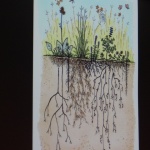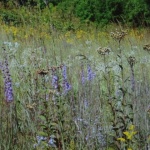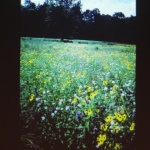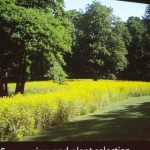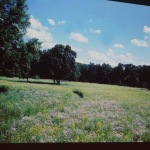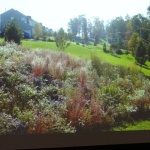Our garden club friend Connie Hoge invited me to attend a lecture if I could sign up in time. The speaker was Larry Weaner, who is well known in the sustainable planting circles. It was organized by George Washington University’s Master’s Degree Program in Landscape Design and Dumbarton Oaks Park Conservancy.
Larry was talking about how to build a sustainable meadow. One of his points was that for building a meadow, the horticulturalist’s approach of beefing up soil with amendments is counterproductive. Too rich of a soil mix leads to higher maintenance because weeds will grow rampantly and crowd out desired plants. Most our our native meadow flowers are sun lovers and prefer a dry, infertile soil. Trying to grow them in well amended soil causes them to become lax and floppy, which is aesthetically displeasing. In a rich soil, the most aggressive plants will dominate. In a poorer soil, other desirable plants have a chance to grow and most weeds are less adapted to sunny, less fertile soils. It’s not that one cannot specifically modify spots to plant particularly desired flowers not part of the eco-community; he suggests only doing so on a small scale.
The best advice is to choose plants that are applicable to the place you wish to plant, not those suited to other conditions, i.e. know your site’s ecology and design with the naturally occurring plant communities suitable to it. Know what kind of soil you have (acidic, alkaline pH, clay, rocky, etc), your climate and the characteristics of the topography of the area to be planted. For example, you may have a sunny, wet meadowland versus one with drier conditions or a combination. In each type, certain plants will proliferate. In flood plain areas, the soil is richer and the diversity of plants is less. Again, this is because in those conditions certain species will become very dominant over others and weedy plants likewise are aggressive and both conditions crowd out other plants that can’t compete.
He suggests that the selected plant pallet should be modeled after the best adapted indigenous community. Why? The plants have co-evolved and have connections in how they grow in space and time. These are plants that do not directly compete with one another due to the way their roots grow in different depths of soil. They may have different rates of vegetative growth or have symbiotic relationships within their plant community that helps all the plants of this natural community thrive. It becomes a relatively stable ecosystem with this approach. There is more diversity-up to 5 plants per square foot!
Most of the grasses we are used to are cool season, turf forming types that turn brown in the heat of summer or go dormant. The thick turf prevents other plants from growing. They are primarily European types of grasses and that weeds or flowers that will grow well in their vicinity and likewise came from that Euro grass eco-community. You have to adjust your mowing times to deal with this type of aggressive turf to get a flower meadow to thrive. Our native grasses are warm season, clump forming grasses that provide spaces for other plants to grow in close association. The warm season grasses are those that will allow the most biodiversity.
Meadows aren’t static. Even changing shade patterns can have an effect on what grows. When moisture levels differ from one area to the next in a given year, the plants that display may differ from a previous year. The composition of plants in a meadow changes over time. Some species dominate early on, like annuals in a seed mi that move quickly to flower and set seeds. Other plants, like Rudbeckia hirta, are biennials and will flower in overwhelming numbers in a succeeding year, set seed and die. Then the floral composition changes again as the rudbeckias are only in vegetative phase. Long lived meadow plants establish slowly, putting efforts into root growth. For example, Culver’s Root takes 7 to 10 years of growth before it flowers.
Specific seed mixes can be ordered for your ecosystem’s micro-habitats once the conditions are determined. To get rid of cool season grasses, Larry will use an herbicide or cover the area with black plastic for a growing season to kill or weaken the turf. He recommends no till methods to establish a new meadow; just scarify the surface of the seedbed. Tilling (and pulling weeds out) disturbs the soil, which in a new meadow, is a perpetual source of weed seed generation that direct competes with your desired seedlings. A healthy meadow community’s soil, once established, will build up a seed bank of the preferred desirable species. He uses “nurse crops” of annual oats and wheat as protection for the seedlings. If adding container/live plants, install them in drifts.
The first year, mow high (5-6″) every 6 weeks. Annual weed seeds will blow in; it can’t be prevented, even with a nurse crop. So, cut them off (don’t pull). Once the meadow is established, mow once at the end of winter to control tree/shrub seedling growth. Patrol for any invasive plants twice yearly and use a spot herbicide, perhaps with a sponge applicator. Although, in some cases burning in beneficial, it is very involved with official fire department actions and it tends to favor grass growth.
Mow your meadow pathways and keep them wide to control tick movement. If you see something special, just mow a path over to it so that you can enjoy walking in your meadow and viewing the changing landscape.
Pictures taken from Larry Weaner’s slide presentation during the lecture (click to enlarge)
- Sustainable ecosystem, root depths
- Diversity of grasses and flowers
- Season in a meadow
- A dominating plant in meadow succession
- Keep paths wide
- Meadow style plantings in suburban setting

